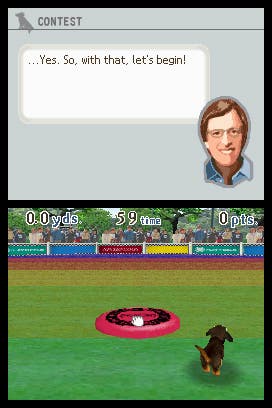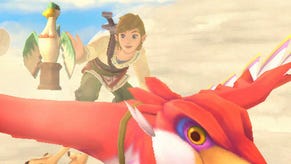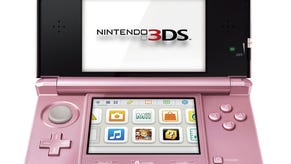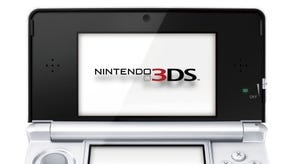Nintendogs
Dog's dinner or our new best friend?
It's finally here - the pet sim that has taken the US and Japan by storm and sold a whole load of DS units to a whole load of people. We previewed the Japanese game back in June, but now we've had the chance to try out the English language version and find out just what all those text screens actually mean. And here's what else we've learned...
First off, we'd disagree with those who claim that Nintendogs is nothing more than a glorified Tamagotchi. And we'd disagree with those who argue that it's not a "proper game" - it involves making choices, interacting with characters and achieving objectives on a games console, which means it's a game as far as we're concerned. All right, so it doesn't have a plot as such, but neither does Pong.
But nor is it, as others have claimed, a perfect game. It does have flaws and limitations, and these are such that some people will find Nintendogs just isn't for them - at least, not in the long term.
As for us? Well, we're enchanted by it, since it's a highly engaging and entertaining game and one that makes excellent use of the DS's unique capabilities. Plus it's got puppies in it.
Puppy love
That is, of course, Nintendogs' greatest hook - the puppies themselves. They really are incredibly lifelike in terms of both how they look and behave, and it's impossible not to be charmed the first time your chosen dog looks up at you and paws the touch screen. Use the stylus to rub its head, scratch its ears and see it joyfully respond, and that's it - you're lost. We were, anyway.

There are six breeds to choose from at the start of the game, and these vary depending on which version you've purchased - Dachshund, Chihuahua or Labrador. We were playing the former, and for our first puppy we selected a male golden retriever billed as being "ideal for first-time owners." There are plenty of personality types to choose from for each breed and we could have chosen a stubborn husky, a naughty pug or a selfish shih tzu, but we were feeling lazy.
We handed over our $550 (you begin the game with $1000 in the bank) and took our puppy home, where our first task was to pet him until he felt familiar in his new surroundings. Then it was time to give him a name - something heroic and masculine and sophisticated, we thought. Ah yes: Lemar.
It's at this point in the game where you get introduced to a key element of Nintendogs - using the DS's microphone to communicate with your puppies. You have to record yourself saying your chosen name several times, and if your dog understands a light bulb will appear over his head. If not, you'll see a load of red question marks instead.
It's also at this point where you get introduced to one of the game's problems - the voice recognition, though impressive when it works, can be a bit hit and miss. Even after you've made a few successful recordings, you have to get your puppy to respond to your call several times before you're able to progress. If you don't manage to do this quickly enough the game will tell you that your pup has forgotten his name and you'll have to go through the whole recording process again.
In the end it took us a full ten minutes to get it right, by which time the person watching telly in the next room had threatened to stick our DS in a bag with some rocks and throw it in the river if he had to listen to us shouting "Lemar! Lemar! Lemar!" one more time. But luckily, Lemar's memory finally improved, and we were into the game proper.
Break it down
There are three basic components to Nintendogs - caring for your puppy, teaching him new tricks, and making him go out and perform them in front of crowds for money like you're some kind of organ grinder and he's some kind of crazy dog-faced monkey.
But let's start with the caring part - at the most basic level, you have to keep your dog fed and watered, and there's a status screen to tell you when he's feeling hungry or thirsty. Supplies can be purchased down your local shop, where you'll also find brushes, shampoos, toys and accessories.
For those who are wondering what happens to puppies whose owners stop bothering to care for them - no, they don't die. They get fleas and go mental. The guilt caused by turning on your DS to be confronted with a flea-ridden nutter who refuses to respond to you in any way and just wanders around shaking his head like a nodding dog gone bonkers is such that you may never want to turn your DS on again, so be warned.
Along with feeding and watering, your dog will also require regular walking. This involves using the touch screen to draw out a route on a map of your local area, complete with icons showing the location of parks, shops and the like. You'll also see a load of question mark symbols - these will either indicate the location of another dog owner and chum out for a walk, or a surprise gift which your puppy will collect for you.
Dog owners will often give you handy tips, but the gifts are generally a bit rubbish and only good for selling down the second hand shop. Sometimes you'll get something ace though - our favourites include a remote control Mario Kart and a Luigi cap for your doggy.

Most of the walk is spent simply watching your pup stroll along, which is rather dull. There's not much background detail to look at, and although you can move the lead about this doesn't seem to do much in the way of actually controlling the dog. Watching your doggy do a pee is a novelty the first time it happens, but the novelty quickly wears off, as does having to touch its poos with the stylus to clean them up. Oh well, at least it's just like real life.
Turning tricks
On to the trick teaching, which is much more fun. You teach your puppy by drawing a move with the stylus, such as a downward stroke for "Sit", and then recording the name of the trick with the microphone. You can use whatever command you like for each trick and thus incorporate swearing and abuse, if that sort of thing makes you happy. The game offers instructions on to teach basic tricks - lie down, roll over etc. - but there are loads more to discover on your own.
Sadly, here the old voice recognition problem crops up again. Sometimes your dog will pick up on what you're saying after only a few tries, sometimes it'll take an annoyingly long time before the little beggar gets the message. Once dogs have learned a trick, however, they do seem to respond around 80 per cent of the time, which isn't bad. With practice the success rate seems to improve, too - whether that's because the game's AI ensures the dog really is learning or because we learn to say the command in exactly the same tone, we're not sure.
Points mean prizes
Finally we come to the organ grinder/monkey component. The first type of contest you can enter is the Disc Competition, where you chuck a frisbee and, providing your dog makes the catch, earn points according to how far it flew. You can practice with your dog up the park, which is essential if you're going to get past the beginner's class.

It's pretty basic stuff - you just move the stylus in a swift upward stroke to throw the frisbee - but it's great fun, and there's a real sense of pride when you take home your first shiny trophy and wad of prize money.
The Agility Trial is a bit more complex, as you have to use the stylus to guide your dog over a series of hurdles and through a load of tunnels. Slightly trickier, then, but more rewarding as a result.
Then there's the Obedience Trial, where your dog must perform the tricks he's learned in a particular order and within a time limit. This is the least enjoyable of the contests, since it relies not on your use of the stylus but on the voice recognition feature - not, as we've pointed out, the game's strongest point. Obedience Trials can often end in disaster and leave you feeling frustrated, since there's a sense that you've lost not because you or your dog failed to perform but because the technology just isn't good enough.
Trading up
At a basic level, that's all there is to the game - you feed, water, wash and walk your dog, you teach him new tricks and practice his skills, and you try to win contests and cash. Which you can then use to buy new toys, new accessories and even new apartments - and, of course, new puppies.
You can keep up to three pups in your house at a time, and if you tire of them you can ship them off to the doggy hotel and replace them with new models. It's great to watch your puppies play together and to see how they greet new arrivals (Lemar, by the way, didn't take kindly to his new brother at first, but it wasn't long before he and Bedingfield were getting on famously).
You can also connect wirelessly with fellow Nintendog owners and play with each other's pups, which fun for a bit. You can swap breeds and give other players items, too, but be warned that gifts are real gifts - so if you hand over that precious Mario Kart it'll disappear from your own inventory for good.
If you switch on Bark Mode your DS will alert you when another player with the game in the same state is nearby - apparently this big in Japan, but we're frightened of strangers and we have no desire to see their puppies so we probably wouldn't bother.
Diff'rent strokes
All in all, just like there are dog people and cat people, we reckon there are Nintendogs people and... erm... people who won't like Nintendogs very much. Partly due to the nature of the game itself, partly due to the nature of the gamer, and partly due to Nintendogs' limitations.
The problem is that you're restricted in terms of how quickly you can progress through the game. You can only enter three contests a day and if you fail to win one, tough luck - no cash prize and you'll drop down a class, so tomorrow you'll have to repeat a contest you've already won once. In addition, dogs can only learn a maximum of three tricks a day and the game will only let you walk them once every half an hour on the grounds that they're knackered.
Which means that while Nintendogs is ideally suited to short gaming bursts, it's pretty useless if you fancy a long session or want to make quick progress. It takes less than an hour to care for your pup, walk him, teach him all the new tricks he can handle and enter all the contests. As a result, it's fine for the commute to work (providing you don't mind non-gaming commuters wondering why you're shouting "SIT" into a small silver object) but no good if you're on an eight hour flight.
But these problems can't detract from the fact that Nintendogs is an amazing piece of software. We've said it before but we'll say it again - the puppies are astonishingly realistic, and very easy to become attached to. This in itself makes for an incentive to keep on playing the game day after day, but there's also the fact that there are so many funky items (oh, how we long for the pirate hat) and different breeds (oh, how we long for the Shetland sheepdog) to collect.
Yes, the basic feed-train-compete mechanics are always there no matter how many puppies you own. And if you're lacking in patience, you're likely to get frustrated with the endless walking and dodgy voice recognition. But we challenge any child, dog lover or generally soppy individual not to enjoy Nintendogs, and not to fall in love with their fluffy little bundles of fun. Not a perfect game, no, but one of the freshest, most innovative and all-round entertaining titles we've played for a while.











